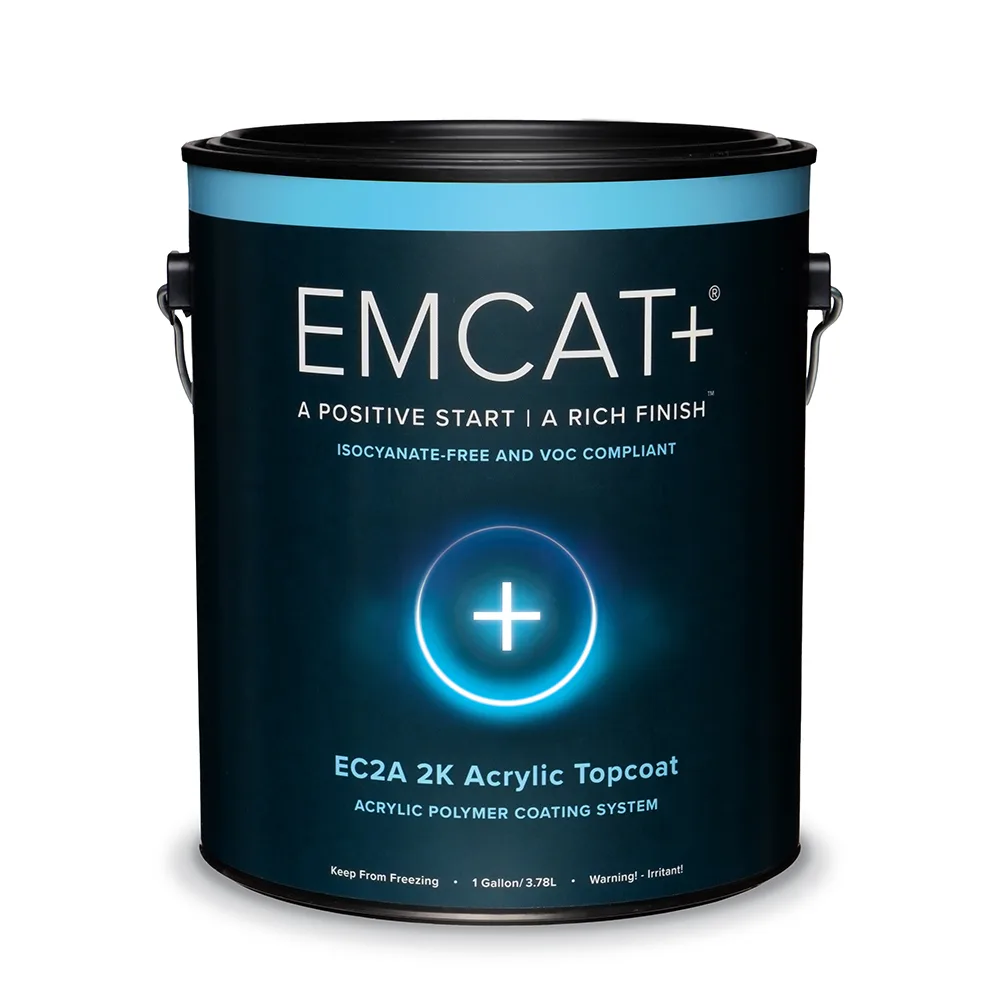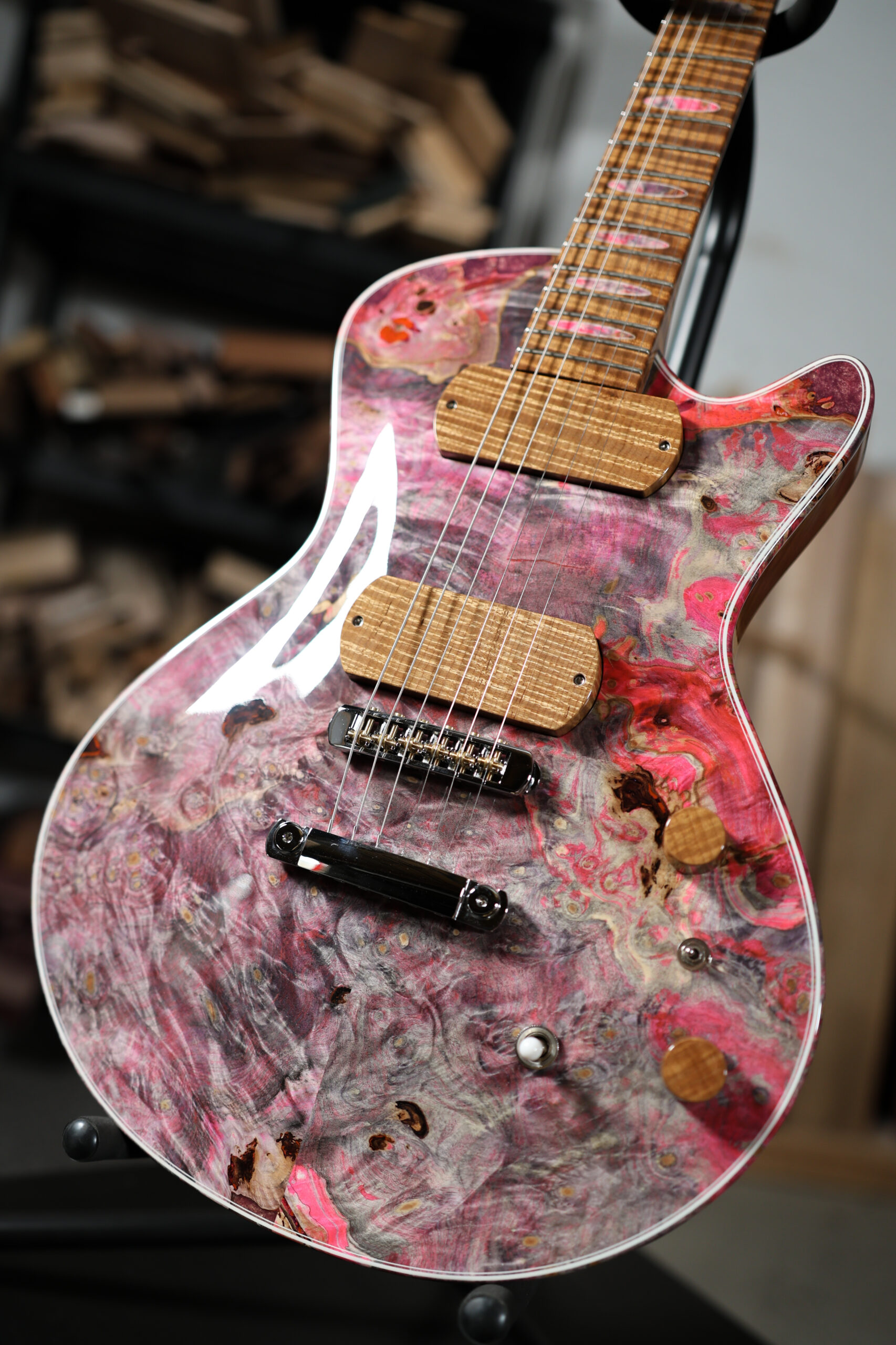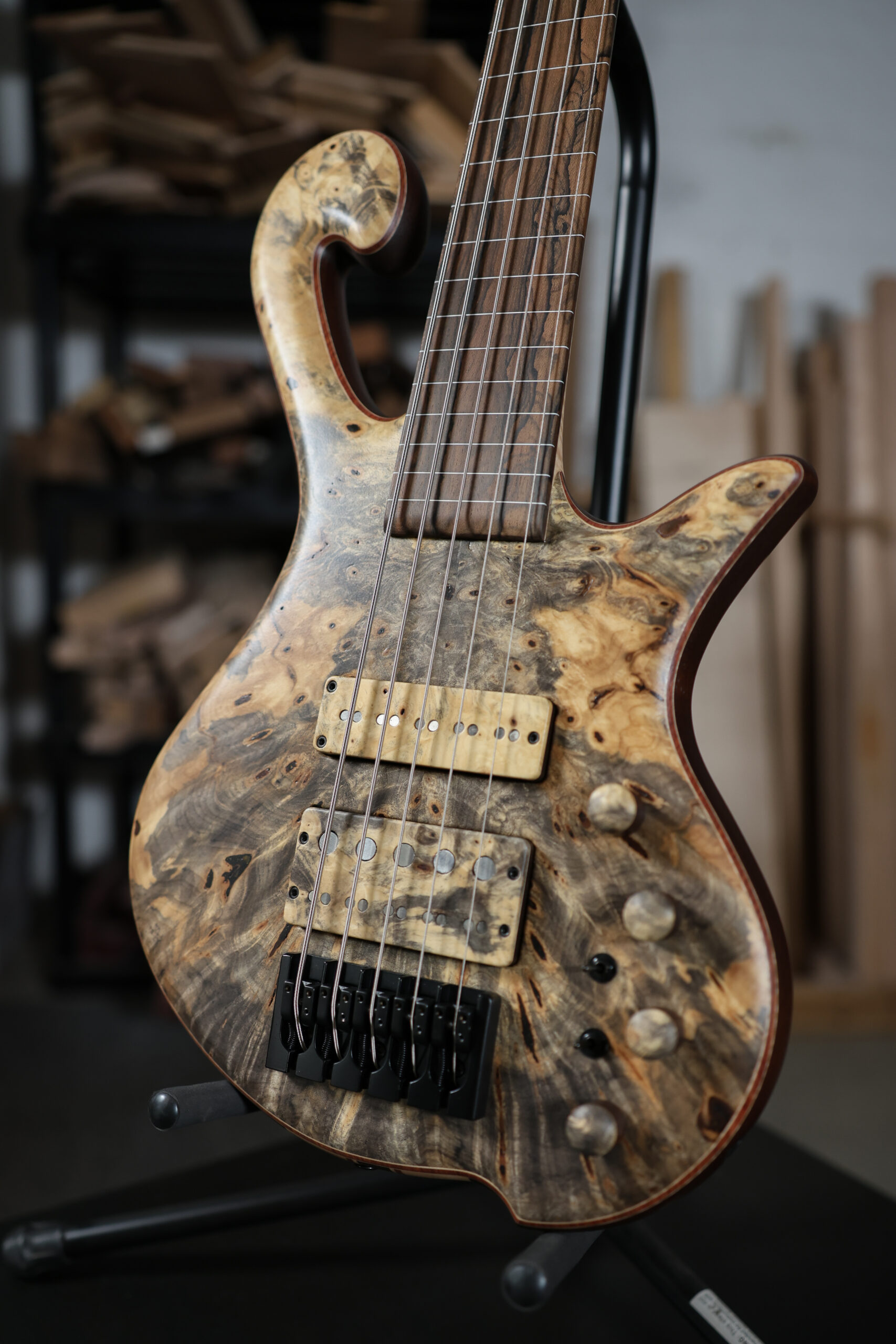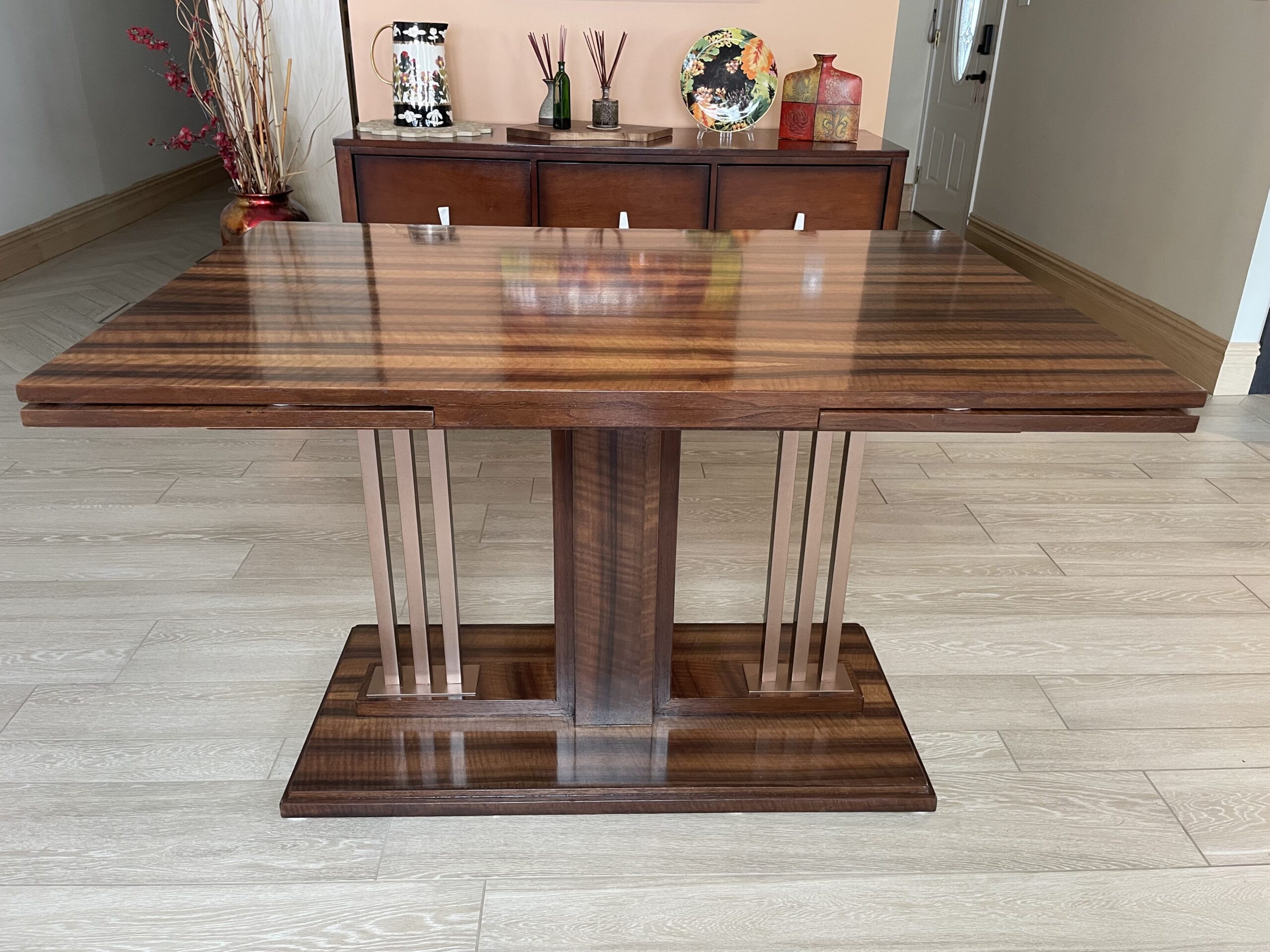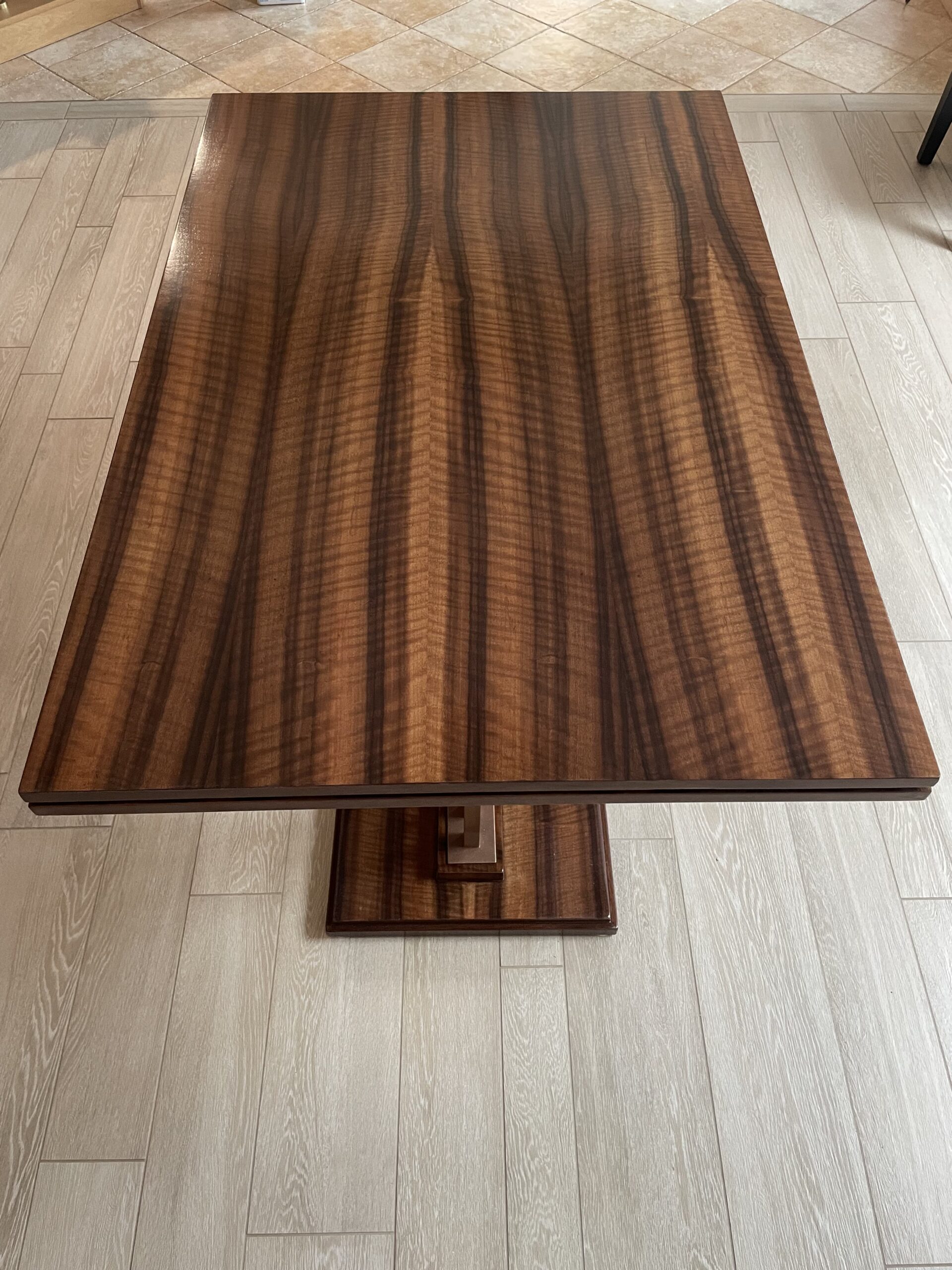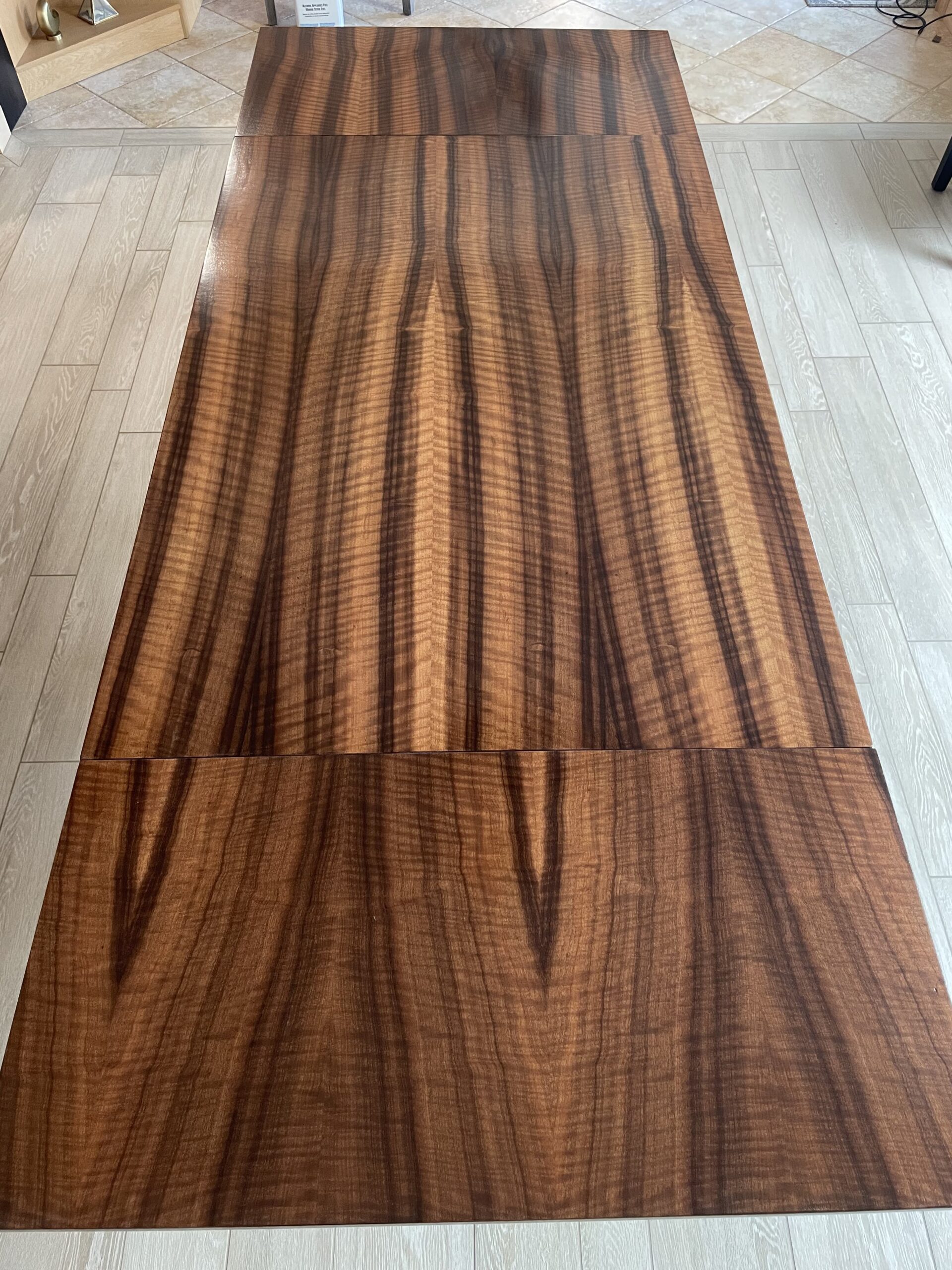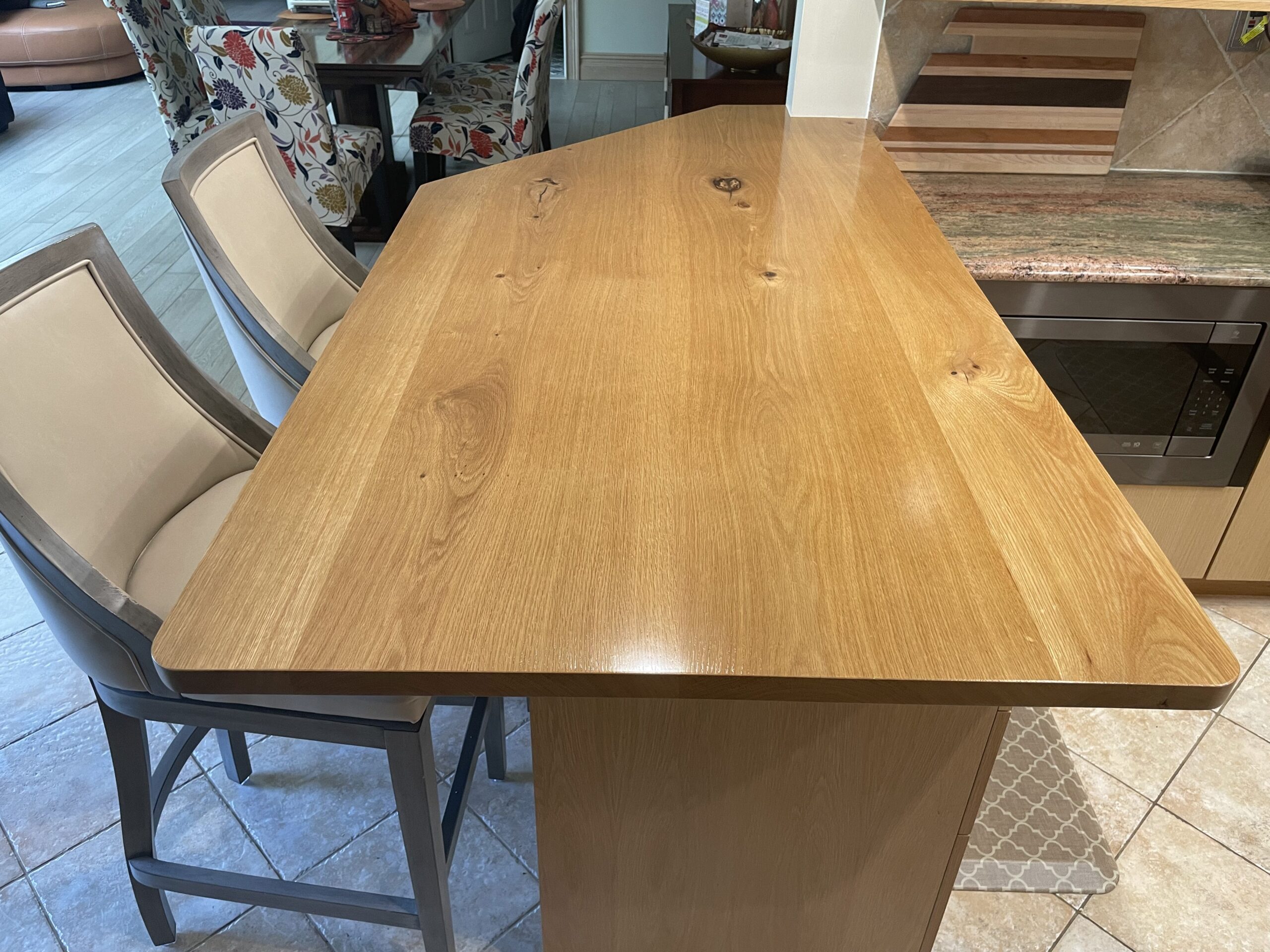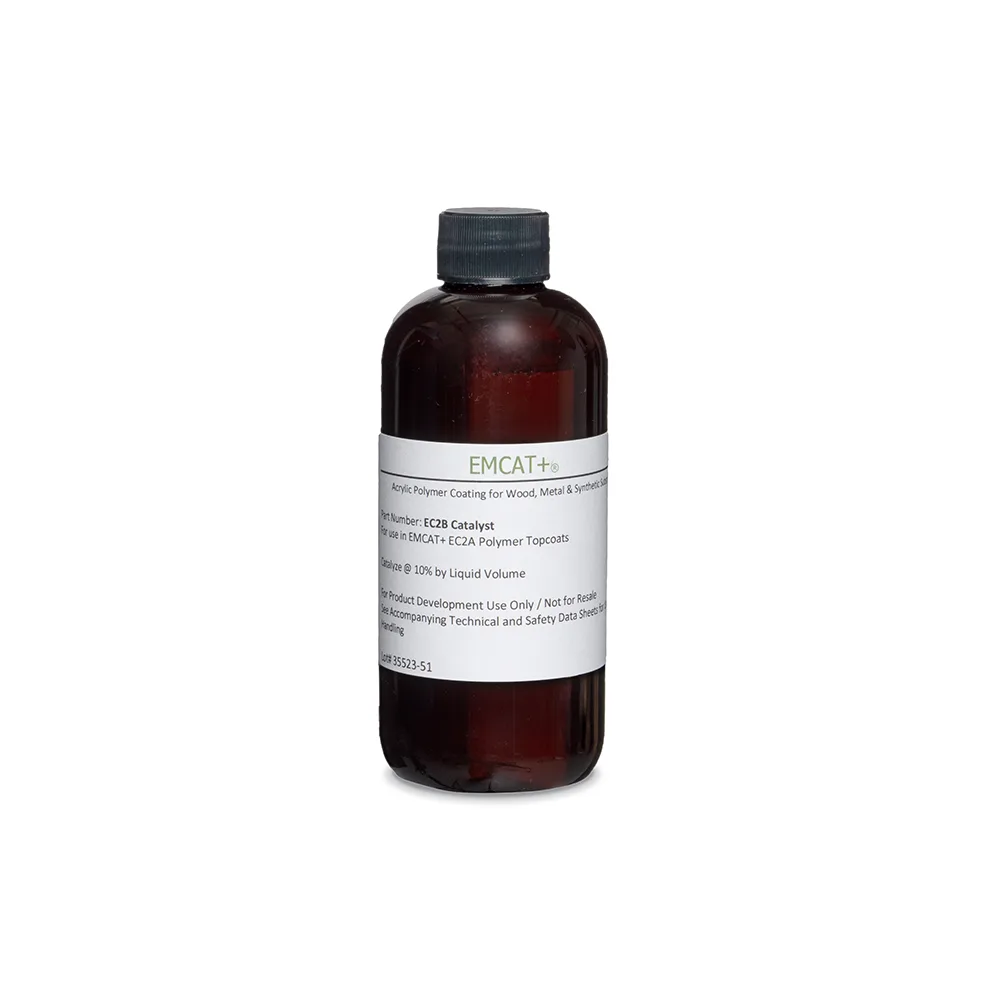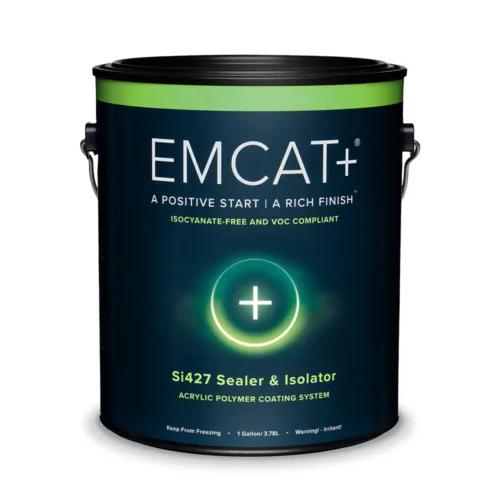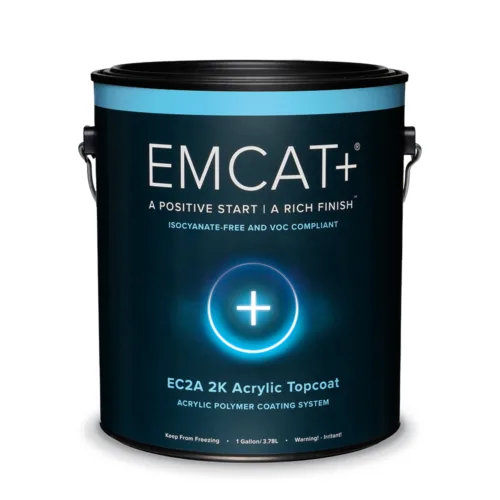EMCAT+® EC2A 2K Topcoat Kit is Part – A of an Ultra-Low VOC and HAPs Free, acid functional, water-based acrylic polymer coating specifically formulated as a 2-component Clear Topcoat and designed to be used as a stand-alone finish, or in tandem with Emcat+® Si427 Sealer and Isolator for custom residential and commercial applications. EC2A Topcoat is a non-yellowing and self-leveling finish that utilizes advanced resins to provide a tough yet flexible, ultra-clear topcoat without the need for a highly toxic isocyanate or aziridine catalyst.
EMCAT+® EC2A features a unique ionic charge that allows it to bond to a wide variety of properly prepared substrates including all types of wood surfaces (oily, exotic hardwoods, veneers, engineered wood products, etc.), and a wide variety of natural and synthetic surfaces such as stainless steel, stone, plastics, and fiberglass. Emcat+ EC2A is self-sealing but was designed to be used in tandem with Emcat+ Si427 to create a high-build, clear finish with exceptional mar and chemical resistance.
EMCAT+® EC2A is designed to be catalyzed with EMCAT+ EC2B Catalyst at a 10% by liquid volume blend and applied at temperatures above 65°F. EC2A Topcoat is a direct replacement for highly volatile solvent-based or toxic water-based 2K isocyanate catalyzed conversion varnishes and urethanes. This feature gives great latitude of use, safety, and application for the finishing professional when working in a wide range of environments.
EMCAT+® EC2A is available in the following sheens: High Gloss-90°, Satin-30°, Flat-10°, Ultra-Flat -5°.
Directions for Use
Data Sheets
EMCAT+ EC2A Acrylic Resin Topcoat Downloads: TDS | SDS
Measurement Chart for Blending
The Methods of Addition are critical to a successful application.
Blending EC2A Resin with EC2B Catalyst at 10% by Liquid Volume
| | |
|---|
| Resin & Catalyst | Volume (US) | Volume (Metric) |
EC2A-Resin
EC2B-Catalyst | 32 fl. oz.
3 fl. oz. | 946 ml
95 ml |
EC2A-Resin
EC2B-Catalyst | 128 fl. oz.
12.8 fl. oz. | 3785 ml
379 ml |
EC2A-Resin
EC2B-Catalyst | 5 Gallons
64 fl. Oz. | 19 Liters
1.9 Liters |
Measure the exact amount of resin to be blended with the exact measurement of catalyst
Methods of Addition
Pre-measure EMCAT+ EC2B Catalyst 10% by liquid volume of EMCAT+ EC2A resin to be added into. Gently stir the EMCAT+ EC2A resin to be catalyzed while slowly adding the premeasured EC2B.
DO NOT POUR CATALYST INTO THE RESIN WITHOUT SIMULTANEOUSLY STIRRING THE RESIN AT THE SAME TIME – This will create a sandy/gritty finish if the catalyst is not stirred into the resin while adding.
Continue to stir the A/B resin mixture for 2 minutes. Allow the catalyzed resin to settle and react for a minimum of 30 minutes before using. For best results premix A/B compound 30 minutes before applying. This will ensure optimum chemical reaction time and flow/leveling performance of the coating during spray application. The minimum recommended temperature for use of catalyzed material is 65 degrees F. The optimum drying temperature for EMCAT+ A/B resin compounds is 70F-130F.
Properly catalyzed material will be functional for a maximum of 8-12 hours – after which time the catalyst will begin to gel and become a solid, inert mass. Any unused A/B EMCAT+ resin compound can be disposed of in accordance with local sanitation laws.
Directions for Use
- All surfaces to be finished must be clean and free of oil, dust, and contamination that may cause fisheyes or poor adhesion.
- Clean surfaces with denatured alcohol or clean water to remove contamination. Allow the surface to thoroughly dry before proceeding. DO NOT use High pH Cleaning Solutions.
- Fine sand surface to be finished with 180G to 400G sandpaper based on the type of final finish required. If the surface to be finished has a grain-filling type glaze, sealer or paste, please ensure that the systems are compatible with one another by preparing a test panel before proceeding. Certain solvent-based fillers and glazes may prevent proper adhesion of the sealer if not thoroughly dry before application of EC2A. Ensure that grain fillers have been sanded with a minimum of 400G sandpaper and all contamination is removed. Oil based glazes should be air dried and tested to ensure proper adhesion.
- To Catalyze EC2A Topcoat, EC2B Catalyst must be added to EC2A in the proper ratio and mixed properly. Allow the mixture to settle a minimum of 30 minutes before application. Please read and follow mixing directions on EC2B Catalyst TDS. DO NOT USE EC2A WITHOUT ADDING EC2B CATALYST. The coating will not dry if it is not catalyzed.
- Spray apply each coat of EC2A Topcoat with HVLP, Conventional, Airless or Airless/Airassist spray equipment. Consult with your spray gun manufacturer for proper gun setup based on coating viscosity and intended use.
- Optimum application conditions are when the ambient room temperature is between 65° – 75° F. We recommend that application and drying temperatures do not fall below 60°F.
- For a high film formation finish we recommend the application of 2 coats of Emcat+ Si427 and a minimum of 2 coats of Emcat EC2A Topcoat.
- DO NOT mix Emtech products and Emcat+ products while in liquid form to prevent cross contamination. It is imperative that all equipment used be thoroughly cleaned before moving from an Emtech product to an Emcat+ product or vice versa.
Note: We highly recommend the use of nitrile gloves, a NIOSHA approved respirator, and safety glasses during the application and cleanup of this material. Consult the Safety Data Sheet of this material for additional safety and health procedures.
Application Instruction
- After the surfaces to be finished have been properly prepared, remove any final sanding dust and/or contamination with a cloth dampened with a water and alcohol solution mixed 1:1.
- When applying as recommended over Emcat+ Si427 Sealer/Isolator, allow the final coat of Si427 to dry a minimum of 8 hours or overnight. Lightly sand with 400G sandpaper if necessary or if more than 24 hours have passed after the final coat of Si427 has been applied. Wipe with a dry clean cloth to remove dust.
- Using a wooden stirring stick, mix EC2A well. Incorporate any flatteners that may have settled to the bottom. DO NOT SHAKE. Mechanical mixing can be performed with an electric drill set at low speed fitted with a paint mixing bit.
- Catalyze EC2A Topcoat with EC2B Catalyst as per instructions in EC2B TDS. Mix well before using. DO NOT SHAKE. Allow to settle a minimum of 30 minutes. DO NOT mix more product than can be used in an 8-12 hour period.
- EC2A Topcoat can be sprayed without reducing with water. However, additions of distilled water might be required if the coating is drying too quickly in high-temperature/low-humidity environments. SA5 Retarder can also be used to slow down dry times. We recommend a 5-10% reduction as a starting point.
- Apply the required number of coats of EC2A Topcoat to obtain the desired film build. When applied as a self-sealing system we recommend a minimum of 3 coats at 3 mil wet film. When used as recommended in combination with Si427, we recommend a minimum of 2 coats applied at 2-4 mil wet film. There is no limit to the total number of coats of EC2A Topcat that can be applied.
- Allow each coat to dry for a minimum of 45-60 minutes at ambient room temperatures at or above 70°F. Faster recoat times can be achieved with temperatures above 70°F or with forced air drying as high as 130°F.
- Sand with 400G sandpaper, if the previous coat has dried for more than 24 hours, or if required to remove surface imperfections like dust nibs, runs, or sags. Otherwise, sanding is not required between coats.
- Before application of additional coats, remove sanding dust with a dry clean cloth. Remove any potential surface contamination with a solution of 1:1 water and denatured alcohol.
- Clean application and spray equipment immediately when finished. Catalyzed coating will begin to harden and gum up equipment within 8-12 hours of mixing.
- When properly catalyzed the maximum physical characteristics will develop within 24-36 hours of the last application coat of EC2A Topcoat.
Clean-Up Procedures
- All Target Coatings EMCAT+® Series coatings can be cleaned up with fresh, warm water and, when necessary, alcohol. Thoroughly clean all spray gun equipment with warm water, followed by a solution of water and denatured alcohol after each use.
- It is imperative that you DO NOT allow catalyzed EC2A Topcoat to dry and harden in spray gun equipment or on any undesired surfaces. Catalyzed coating will harden in airtight conditions and could render equipment useless. The coating will begin to gel in containers and application equipment within 8-12 hours of mixing.
- DO NOT USE HIGH pH ALKALINE DETERGENT when cleaning Emcat+ Series coatings.
- Thoroughly flush the drain system with water after cleaning.
Average Equipment Use Settings
Conventional Equipment Pressure Pot: If needed, reduce with deionized water up to 10% maximum. Nozzle size: 1.6mm to 1.8mm. Atomizing air: 30 psi–40 psi, Pot pressure 4psi to 8psi. Consult with spray gun manufacturers for optimal pressure settings based on coating viscosity.
HVLP Equipment: If needed, reduce with deionized water up to 10% maximum. Nozzle size: 1.6mm to 1.8mm. Atomizing air: 20 psi – 30 psi. Consult with spray gun manufacturers for optimal pressure settings based on coating viscosity.
Airless Air Assist Equipment (10:1 Pump Ratio): If needed, reduce with deionized water up to 10% maximum. Nozzle size: tip size.010 to .014 inches, fluid pressure 200 psi to 300 psi, atomizing air 20 psi to 25 psi, depending on orientation of the surface being finished and required wet/dry film thickness.
Industrial Hygiene Requirements
Use only in well ventilated areas. Avoid inhaling spray mist. Wear a NIOSH/MSHA approved respirator during spray applications. Use nitrile gloves when handling. Wear safety glasses at all times.
Emergency First-Aid
Ingestion:
Administer large amounts of water.
DO NOT induce vomiting.
Seek immediate medical attention.
Inhalation:
Remove exposed person(s) to a well ventilated area. Treat symptomatically.
Eyes:
Flush with fresh water. Seek medical attention.
Skin:
Wash the exposed area with warm, soapy water. Seek medical attention if irritation occurs.
Disclaimer
The information and suggestions are, to the best of our knowledge, reliable. Since the conditions of use are beyond our control, this company cannot assume responsibility for any risk or liabilities that may result from the use of its products.

